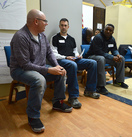
Compassion (n.) - Compassion is being able to put yourself in the shoes of the other person. It says that you are not separate, that the other person is you. Compassion links the suffering in the person across from you directly to your own suffering. It is a link and a bond. It brings people closer together as equals and does not shove them apart or put one person above another.
Pity (n.) - Pity says that you acknowledge another person's pain but you still feel separate. With pity, you cannot see how your own suffering is linked to the suffering in the other person. The other person seems unfortunate and separate. Pity puts one person above another.  Today, we cover the last basic piece of mindfulness: working with your thoughts and the mind. You have learned so far to use your breath as home, bring awareness into your body, and to begin working with your emotions. All of these things layer on top of each other as you work toward greater self-awareness. When you began this practice on Week 3, your homework had you noticing your thoughts, letting them go, and returning to your breath. The part of you that is doing the noticing and issuing the instruction to return is called your observer self.  Today's cognitive distortion is a hotly debated one when I cover it during class. When students are asked if they believe the world is fair, they consistently respond, "Well, of course it isn't. We know that!" But when I drill into the beliefs of what that actually means, I start to see some resistance. When I ask, "Is hard work always rewarded?" people will say yes or that it is rewarded most of the time. But is it? Often times, this is when the older people in class will speak up and share their personal stories about how they first learned that statement wasn't true. People really don't like to hear this one. It speaks to a lot of people's current struggle. This is why the Just-World Hypothesis is so hard to shake in people.  Don’t teach people what they can discover on their own. There are portions of every training class where the intent is to relay a list of rules or to help the students better understand an underlying issue. The old method of getting this information across was through lecture. And, lecture, in terms of retention, is not always the best way to get the information to stick and be internalized by your students. By splitting your class into small groups and using discussion cards, you can actually increase retention, comprehension, and also make your class a lot more engaging and fun.  Emotional Mirror (n.) - When you smile at a baby, the baby smiles back. When you scowl, the baby scowls back. The mirror system in the baby's brain is what creates this effect. We see this in adults when we react to another person's pain by feeling a sympathy pain of our own or unconsciously reflect back another's facial expression or mood. We naturally mirror what is presented to us.  Emotional intelligence is about being aware of our own and other’s emotions, being able to regulate those emotions, and also being able to express what we feel in effective ways. This week, we add the base level of working with your emotions into your mindfulness practice The practice skill for this week will help you learn to identify and become more aware of your emotions. This is a base level skill that we will expand on in the future but, for now, we need to build a solid base before adding the more in depth material later.  The Barnum (or Forer) Effect is most associated with horoscopes and "cold readings." It occurs when people rate personal assessments about their character or life as highly accurate even when those assessments are so general or vague that they could apply or be true for almost anybody. There is also a sense that people will believe some things to be true simply because they really want those things to be true. When people are told exactly what they want to hear, they don't often ask for or need proof to believe what they are told.  When doing a workshop or class, the limit of planned lecture time before moving to an activity or form of engaged learning is roughly ten minutes – much beyond that and people’s attention spans just aren’t there. One of the ways to get the class moving and increase their engagement is to do a Four Corners or a Human Graph activity. Both of these activities get your students up, out of their chairs, and moving around the classroom. They can even be used to help with knowledge retention. |
My Writing and Other Resources for StudentsA growing collection of writing and other resources for students to use to continue their growth.
|


 RSS Feed
RSS Feed